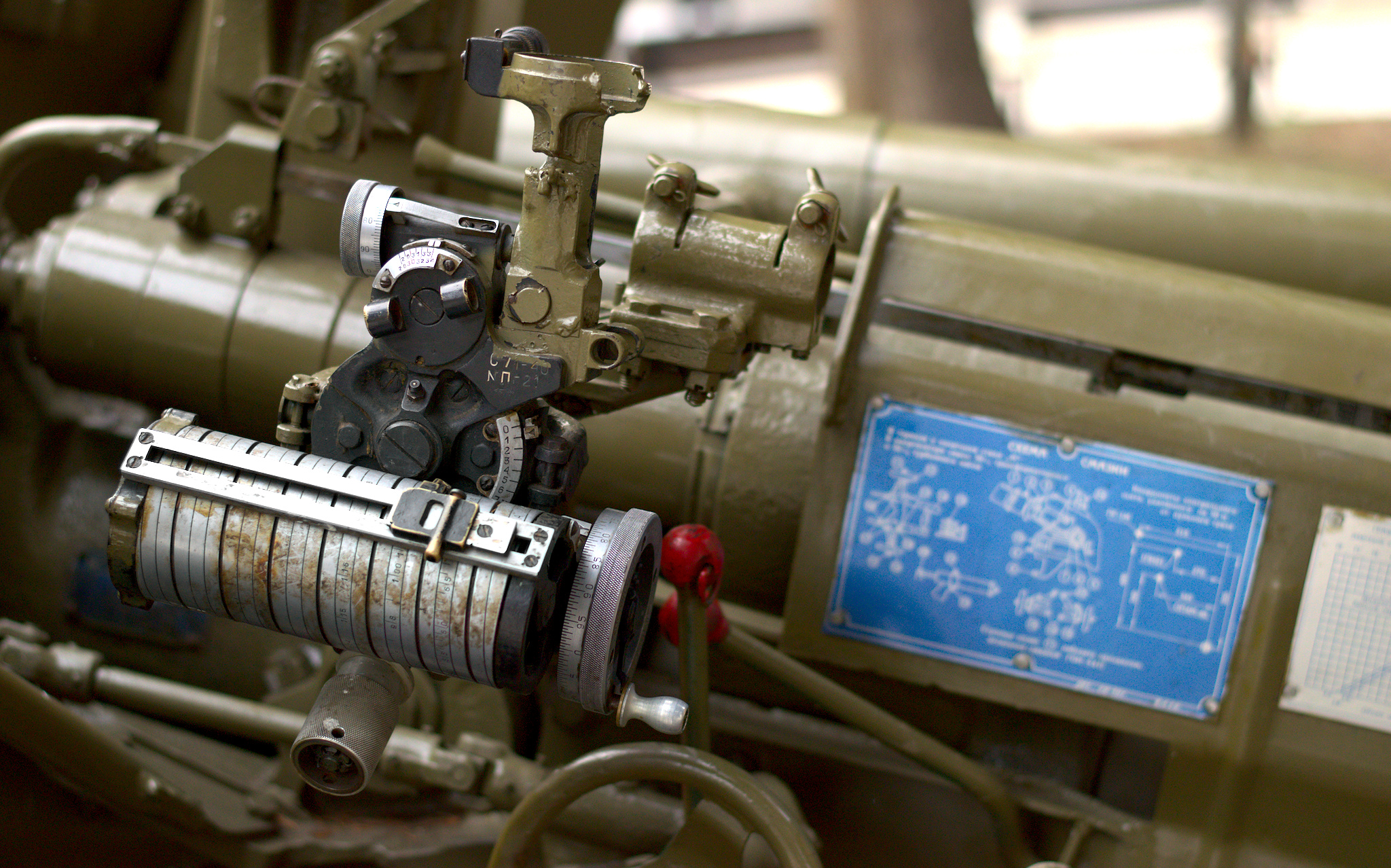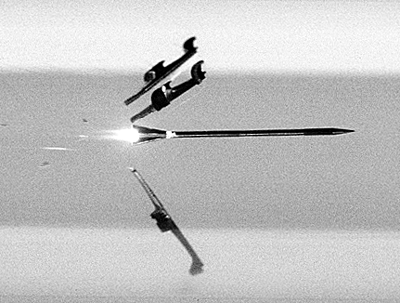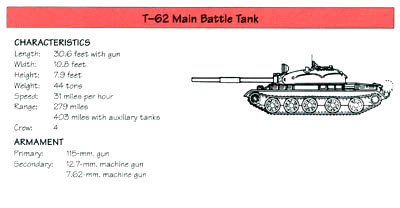|
T-12 Antitank Gun
2A19 or T-12 was a revolutionary Soviet 100-mm anti-tank gun. It was the first (anti-) tank gun to adopt a smoothbore barrel, and to introduce modern armor piercing shot, like the APFSDS. It uses long projectiles that are more powerful than its caliber suggests. The T-12 served as the primary towed anti-tank artillery in the Soviet and Bulgarian armies from the early 1960s to the late 1980s. History The T-12 was designed by the construction bureau of the Yurga Machine-Building Plant as a replacement for the BS-3 100 mm gun. The first serial examples were produced in 1955, but the T-12 entered service only in 1961. Its special feature was the use of a smoothbore gun. The T-12 was typically deployed in the anti-tank units of armored and motor rifle regiments to protect flanks against counter-attacks during rapid advances. In 1971 a new variant was introduced, T-12A or MT-12 "Rapira" (2A29). This has the same barrel, but has a redesigned carriage and gun shield. This allows ... [...More Info...] [...Related Items...] OR: [Wikipedia] [Google] [Baidu] |
Saint Petersburg
Saint Petersburg ( rus, links=no, Санкт-Петербург, a=Ru-Sankt Peterburg Leningrad Petrograd Piter.ogg, r=Sankt-Peterburg, p=ˈsankt pʲɪtʲɪrˈburk), formerly known as Petrograd (1914–1924) and later Leningrad (1924–1991), is the second-largest city in Russia. It is situated on the Neva River, at the head of the Gulf of Finland on the Baltic Sea, with a population of roughly 5.4 million residents. Saint Petersburg is the fourth-most populous city in Europe after Istanbul, Moscow and London, the most populous city on the Baltic Sea, and the world's northernmost city of more than 1 million residents. As Russia's Imperial capital, and a historically strategic port, it is governed as a federal city. The city was founded by Tsar Peter the Great on 27 May 1703 on the site of a captured Swedish fortress, and was named after apostle Saint Peter. In Russia, Saint Petersburg is historically and culturally associated with t ... [...More Info...] [...Related Items...] OR: [Wikipedia] [Google] [Baidu] |
High-explosive Anti-tank
High-explosive anti-tank (HEAT) is the effect of a shaped charge explosive that uses the Munroe effect to penetrate heavy armor. The warhead functions by having an explosive charge collapse a metal liner inside the warhead into a high-velocity explosively formed penetrator (EFP) jet; this is capable of penetrating armor steel to a depth of seven or more times the diameter of the charge (charge diameters, CD). The EFPs jet effect is purely kinetic in nature; the round has no explosive or incendiary effect on the target. Because they rely on the kinetic energy of the EFP jet for their penetration performance, HEAT warheads do not have to be delivered with high velocity, as an armor-piercing round does. Thus they generate less recoil. The performance of HEAT weapons has nothing to do with thermal effects, with HEAT being simply an acronym. History HEAT warheads were developed during World War II, from extensive research and development into shaped charge warheads. Shaped char ... [...More Info...] [...Related Items...] OR: [Wikipedia] [Google] [Baidu] |
Stockholm International Peace Research Institute
Stockholm International Peace Research Institute (SIPRI) is an international institute based in Stockholm. It was founded in 1966 and provides data, analysis and recommendations for armed conflict, military expenditure and arms trade as well as disarmament and arms control. The research is based on open sources and is directed to decision-makers, researchers, media and the interested public. SIPRI's organizational purpose is to conduct scientific research in issues on conflict and cooperation of importance for international peace and security, with the goal of contributing to an understanding for the conditions for a peaceful solution of international conflicts and sustainable peace. SIPRI was ranked among the top three non-US world-wide think tanks in 2014 by the University of Pennsylvania Lauder Institute's ''Global Go To Think Tanks Report.'' In 2020, SIPRI ranked 34th amongst think tanks globally. History In 1964, Prime Minister of Sweden Tage Erlander put forward the id ... [...More Info...] [...Related Items...] OR: [Wikipedia] [Google] [Baidu] |
T-12 Operators
T1, T01, T.1 or T-1 may refer to: Biology * The first of the thoracic vertebrae in the vertebral column * Thoracic spinal nerve 1, a nerve emerging from the vertebrae * Cyclin T1, a human gene * GalNAc-T1, a human gene * Ribonuclease T1, a fungal endonuclease * TNM staging system, classification for a small cancer tumor Computing * Apple T1, a system on a chip used by Apple * T1 font, or cork encoding, a character encoding * T1, a component of the T-carrier system for telecommunication * UltraSPARC T1, a microprocessor Transportation Aircraft * Raytheon T-1 Jayhawk, a jet aircraft used by the US Air Force for advanced pilot training * Lockheed T2V SeaStar, a.k.a. T1 Seastar, a carrier-capable jet trainer in the US Navy * Fuji T-1, Japan's first jet-powered trainer aircraft * Sopwith Cuckoo, a British biplane torpedo bomber of 1918 Automobiles * Bentley T-series, Bentley Motors model in the UK * Caparo T1, a 2006 British sports car * CWS T-1, first serially-built car manufactur ... [...More Info...] [...Related Items...] OR: [Wikipedia] [Google] [Baidu] |
APFSDS
Armour-piercing fin-stabilized discarding sabot (APFSDS), long dart penetrator, or simply dart ammunition, is a type of kinetic energy penetrator ammunition used to attack modern vehicle armour. As an armament for main battle tanks, it succeeds Armour-Piercing Discarding Sabot (APDS) ammunition, which is still used in small or medium caliber weapon systems. Improvements in powerful automotive propulsion and suspension systems following World War II allowed modern main battle tanks to incorporate progressively thicker and heavier armour protection systems, while maintaining considerable maneuverability and speed on the battlefield. As a result, achieving deep armour penetration with gun-fired ammunition required even longer anti-armour projectiles fired at even higher muzzle velocity than could be achieved with stubbier APDS projectiles. History Armour-piercing discarding sabot (APDS) was initially the main design of the kinetic energy (KE) penetrator. The logical progressio ... [...More Info...] [...Related Items...] OR: [Wikipedia] [Google] [Baidu] |
100mm APFSDS 3BM2
1 (one, unit, unity) is a number representing a single or the only entity. 1 is also a numerical digit and represents a single unit of counting or measurement. For example, a line segment of ''unit length'' is a line segment of length 1. In conventions of sign where zero is considered neither positive nor negative, 1 is the first and smallest positive integer. It is also sometimes considered the first of the infinite sequence of natural numbers, followed by 2, although by other definitions 1 is the second natural number, following 0. The fundamental mathematical property of 1 is to be a multiplicative identity, meaning that any number multiplied by 1 equals the same number. Most if not all properties of 1 can be deduced from this. In advanced mathematics, a multiplicative identity is often denoted 1, even if it is not a number. 1 is by convention not considered a prime number; this was not universally accepted until the mid-20th century. Additionally, 1 is the s ... [...More Info...] [...Related Items...] OR: [Wikipedia] [Google] [Baidu] |
Rolled Homogeneous Armour
Rolled homogeneous armour (RHA) is a type of vehicle armour made of a single steel composition hot-rolled to improve its material characteristics, as opposed to layered or cemented armour. Its first common application was in tanks. After World War II, it began to fall out of use on main battle tanks and other armoured fighting vehicles intended to see front-line combat as new anti-tank weapon technologies were developed which were capable of relatively easily penetrating rolled homogeneous armour plating even of significant thickness. Today, the term is primarily used as a unit of measurement of the protection offered by armour on a vehicle (often composed of materials that may not actually contain steel, or even contain any metals) in equivalent ''millimetres of RHA'', referring to the thickness of RHA that would provide the same protection. Typically, modern composite armour can provide the same amount of protection with much thinner and lighter construction than its protectiv ... [...More Info...] [...Related Items...] OR: [Wikipedia] [Google] [Baidu] |
Sight (device)
A sight is an aiming device used to assist in visually aligning ranged weapons, surveying instruments or optical illumination equipments with the intended target. Sights can be a simple set or system of physical markers that have to be aligned together with the target (such as iron sights on firearms), or optical devices that allow the user to see an optically enhanced — often magnified — target image aligned in the same focus with an aiming point (e.g. telescopic sights, reflector sights and holographic sights). There are also sights that actively project an illuminated point of aim (a.k.a. "hot spot") onto the target itself so it can be observed by, such as laser sights and infrared illuminators on some night vision devices. Simple sights At its simplest, a sight typically has two components, front and rear aiming pieces that have to be lined up. Sights such as this can be found on many types of devices including weapons, surveying and measuring instruments, and nav ... [...More Info...] [...Related Items...] OR: [Wikipedia] [Google] [Baidu] |
Muzzle Brake
A muzzle brake or recoil compensator is a device connected to, or a feature integral to the construction of, the muzzle or barrel of a firearm or cannon that is intended to redirect a portion of propellant gases to counter recoil and unwanted muzzle rise. Barrels with an integral muzzle brake are often said to be ported. The concept of a muzzle brake was first introduced for artillery. It was a common feature on many anti-tank guns, especially those mounted on tanks, in order to reduce the area needed to take up the strokes of recoil and kickback. They have been used in various forms for rifles and pistols to help control recoil and the rising of the barrel that normally occurs after firing. They are used on pistols for practical pistol competitions, and are usually called compensators in this context.STI article on Limcat Under ... [...More Info...] [...Related Items...] OR: [Wikipedia] [Google] [Baidu] |
85 Mm Anti-tank Gun D-48
The 85-mm antitank gun D-48 (russian: 85-мм противотанковая пушка Д-48) was a Soviet 85-mm calibre anti-tank gun used after World War II. It was designed as the replacement for the 100 mm field gun M1944 (BS-3). Distinguishing features of the D-48 include a very long barrel and a pepper-pot muzzle brake. The D-48 was itself replaced in the 1960s by the T-12 antitank gun. Overview The gun was designed by the F. F. Petrov Design Bureau on the basis of the D-44 85-mm divisional gun and production of the D-48 began in 1953 at the No. 75 factory in Yurga. The D-48 used the breechblock from the BS-3 100-mm field gun in order to achieve a rate of fire of 15 rounds per minute at maximum cadence. The gun can transition from march to combat order in about two minutes. The D-48N was a version with an APN 2-77 or 3-77 infrared imaging device fitted for night combat. A licensed version of the D-48 was produced in China as the Type 60. The gun fires a high velocity a ... [...More Info...] [...Related Items...] OR: [Wikipedia] [Google] [Baidu] |
T-12 Anti-tank Gun Aiming Mechanism
T1, T01, T.1 or T-1 may refer to: Biology * The first of the thoracic vertebrae in the vertebral column * Thoracic spinal nerve 1, a nerve emerging from the vertebrae * Cyclin T1, a human gene * GalNAc-T1, a human gene * Ribonuclease T1, a fungal endonuclease * TNM staging system, classification for a small cancer tumor Computing * Apple T1, a system on a chip used by Apple * T1 font, or cork encoding, a character encoding * T1, a component of the T-carrier system for telecommunication * UltraSPARC T1, a microprocessor Transportation Aircraft * Raytheon T-1 Jayhawk, a jet aircraft used by the US Air Force for advanced pilot training * Lockheed T2V SeaStar, a.k.a. T1 Seastar, a carrier-capable jet trainer in the US Navy * Fuji T-1, Japan's first jet-powered trainer aircraft * Sopwith Cuckoo, a British biplane torpedo bomber of 1918 Automobiles * Bentley T-series, Bentley Motors model in the UK * Caparo T1, a 2006 British sports car * CWS T-1, first serially-built car manufactur ... [...More Info...] [...Related Items...] OR: [Wikipedia] [Google] [Baidu] |
T-62
The T-62 is a Soviet Union, Soviet main battle tank that was first introduced in 1961. As a further development of the T-54/T-55, T-55 series, the T-62 retained many similar design elements of its predecessor including low profile and thick turret armour. In contrast with previous tanks, which were armed with rifled tank guns, the T-62 was the first production tank armed with a smoothbore tank gun that could fire Armour-piercing fin-stabilized discarding sabot, APFSDS rounds at higher velocities. While the T-62 became the standard tank in the Soviet arsenal, it did not fully replace the T-55 in export markets due to its higher manufacturing costs and maintenance requirements compared to its predecessor. Although it was followed by later models in successor states of the Soviet Union, the T-62 remained in reserve in the former USSR and in frontline use by other countries. Design features of the T-62 became standardized in subsequent Soviet and Russian mass-produced tanks. De ... [...More Info...] [...Related Items...] OR: [Wikipedia] [Google] [Baidu] |







